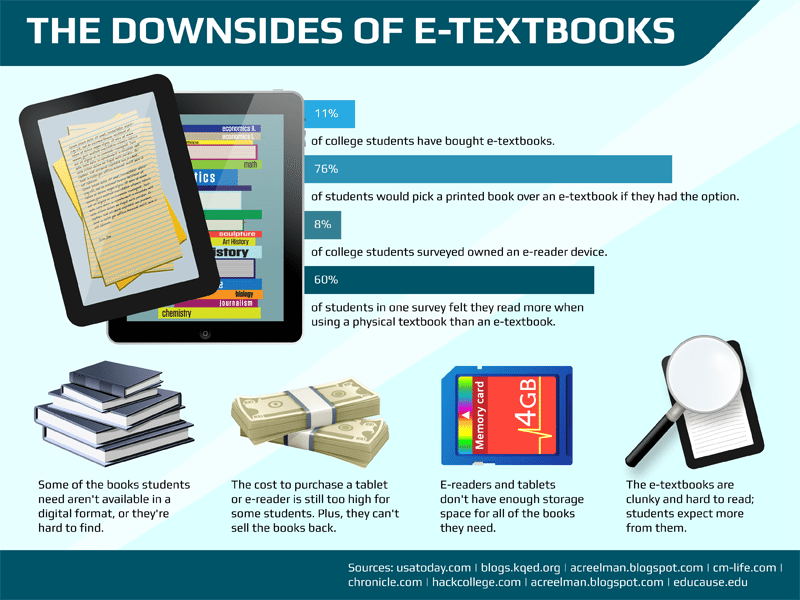
Why Aren’t Students Using Digital Textbooks?
by TeachThought Staff
When eTextbooks were first introduced, they were supposed to be the wave of the future and experts thought we’d see eReader-toting students littering college campuses, and of course being adopted in droves by online university students.
But they haven’t taken off quite as expected: according to market research firm Student Monitor, only about 11% of college students have bought e-textbooks. So what happened? Here, we’ll explore several reasons why students aren’t yet warming up to the idea of eTextbooks today.
1. The books they need aren’t available in digital format
For many students, e-book use isn’t about preference or price, but instead, availability. The books that students need for school are often simply not available in a digital format. Even when certain titles are available digitally, students typically take an all-or-nothing approach to their textbook purchases each semester, buying all of their books at the same location. When so few books are available as eTextbooks, they just don’t bother trying to find them.
2. They are not as affordable as you might think
Cutting out the cost of physically producing and shipping a textbook is a money-saver for sure, but a recent study has found that most of the time, that savings does not get passed on to students. In fact, for most students, eTextbooks saved them a whopping $1. What gives? The high cost of eReaders like the iPad and Kindle, “publisher pricing decisions,” and the fact that if students rent eBooks, they can’t sell them back later all add up to the surprisingly high cost of e-textbooks.
3. You can’t lend or resell most e-textbooks
Unlike printed material, textbooks that are downloaded to your e-reader stay there and don’t go anywhere else. So students who might share a book with their roommate run into difficulty, and those who are accustomed to reselling books at the end of the semester hit a brick wall as well. Students find it hard to deal with these restrictions when they are used to the ease of sharing paper books.
4. It feels strange to mark up an e-book
Although most eBooks come outfitted with a small army of tools that allow students to bookmark, highlight, take notes, and explore through footnotes, definitions, and more, students just aren’t impressed. They often still prefer tangible books that they can physically highlight and write notes in the margins of. Even those who might be open to digital markup are wary that they might lose their notes.
5. e-Textbooks are heavy, too
eTextbooks were supposed to replace the pounds upon pounds of paper books that college students stuff their backpacks with. But digital books are heavy in a different way: their storage size. Even on a 64GB iPad, there’s simply not enough room to store every single book a student might need. Assuming students are using their iPads solely for books (they aren’t), books that can be up to 10GB each leaves room for just about eight books on one device.
6. There are better digital options available
When you consider the wealth of media-rich alternatives available to students online, some e-textbooks with just plain print and images seem downright primitive. Video, audio, interactive websites and activities can often be accessed using iPads and other eReaders with web browsing. Students may find this material to be more helpful than what eTextbooks have to offer.
7. Today’s students grew up with books
Part of the reason for the slow adoption of eTextbooks is the simple fact that today’s students just aren’t used to them. They grew up with textbooks in grade school, and they’re simply not interested in making a change. Experts believe that students who grow up using eBook devices will be much more open to continuing the trend when they reach college.
8. eBooks offer a different experience
One might think that reading a textbook is basically the same in any format. But some researchers believe that the brain absorbs digital and printed text differently. In one study, students who read printed books seemed to more fully understand material and did so much faster than another group of students who read the same material in a digital format. They explain that, in their perspective, digital vs. print reading is much like the difference between ‘knowing’ and ‘remembering.’
9. Finding e-textbooks is a scavenger hunt
Some textbooks are available in one format, and not the other, or available to download through several different stores. That means students not only have to hunt down their textbooks across several different platforms and websites, they also have to remember where they are, learn how to navigate and use each reader, and typically, maintain logins for all of them. One student describes the experience as a “sick, expensive scavenger hunt” that makes “as much sense as going to three separate grocery stores to buy eggs, bread, and milk.” Although eTextbooks are thought to be a simpler solution, they really can’t be until students can utilize them on a unified platform.
10. Students expect more from digital editions
Students today are used to digital tools that allow them to share everything from pictures of their morning cup of coffee to their notes from class. Put a book on an eDevice, and they expect the same. So when they run into restrictions and a lack of social tools when using eTextbooks, they’re understandably disappointed. They’re looking for social reading app integrations, shared highlighting, and the ability to take advantage of web-based tools, not just reading.
